The biggest reason people don’t take the time to walk their dogs is because they feel as though they can’t safely walk their dogs.
This is TRAGIC! …Let's dive into this guide to loose-leash training and find some lovely dog walking solutions…
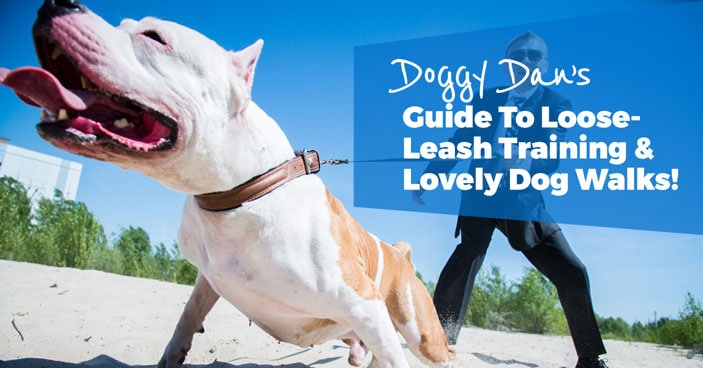
Key Takeaways
- Providing dogs with routine daily exercise is an important part of being a responsible dog owner
- Dogs need to be introduced to other dogs slowly and carefully to avoid any aggression or excitement
- Leash training takes time and patience, but is an important skill for any dog owner
Table Of Contents
Providing dogs with routine daily exercise is an incredibly important part of caring for a canine.
Why?
Because excess energy can quickly lead to your dog turning to naughty behaviors like chewing furniture and getting into the rubbish bin.
(See how I've helped over 88,000 put an end to their naughty behavior here!)
This is even true for all dogs—including well trained dogs. And poor obedience due to a lack of exercise is no fun for anyone.
Here’s the bottom line…
Your dog doesn’t have street smarts, so he can’t take himself on a walk alone. He also doesn’t have thumbs so going out back for a game of “chase the ball” like our kids do, isn't possible.
That means it’s up to you to provide an outlet for your pup before he decides to release his built up energy on tearing your new sofa in half (read up on Separation Anxiety here).
Thankfully, all most dog's need to get rid of the “ants in their pants” is a nice walk around the block each day.
Yet, while a lap or two around the neighborhood to burn your dog's excess energy seems simple, I’ve come in contact with far too many people who avoid walking their dog like the plague.
It’s not that these people don’t WANT to walk their dog. In fact, it’s the exact opposite.
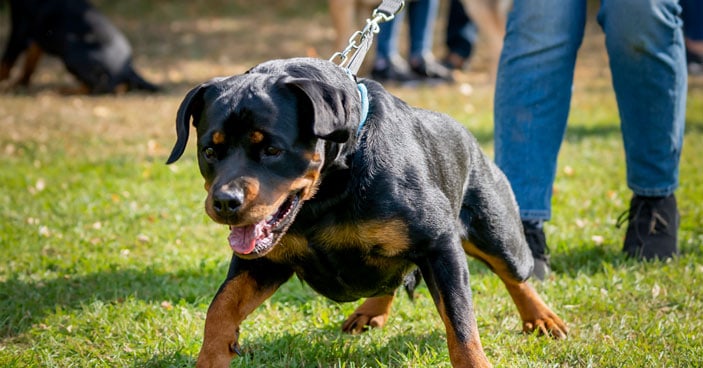
Are you skipping your dog walks, or walking your dog at midnight to avoid the stress?
Between pulling on the leash, dog aggression, and poor leash manners I know exactly the challenges people—perhaps even you—may face on a daily basis.
The bad news…challenging leash behavior is a problem many dog owners struggle with on a daily basis.
The good news…every dog, no matter his problem, can overcome his challenges with bad leash manners.
The best news…I’ve put together the guide to leash training below that addresses common dog walking behavior problems and provides you with solutions to make a walk around you block and enjoyable experience for both you and your dog.
Let’s start with the basics…
How to Walk a Dog
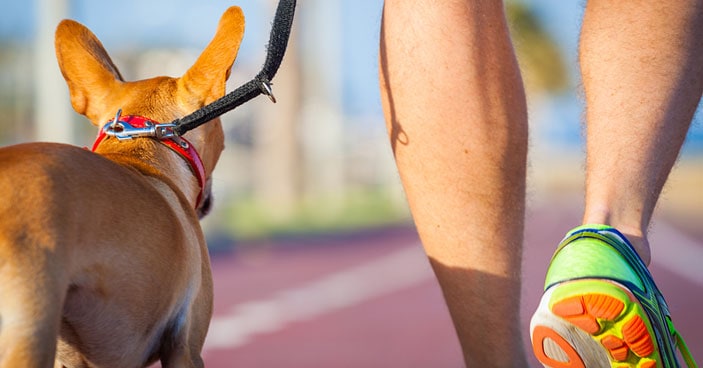
Walking the walk…
Walks are one of the most exciting things in many dog’s lives. So, it is understandable to expect a bit of excitement when they see you grab the leash.
But, a walk is actually so much more than a stroll along the road, and to staying in control of the whole process is an extremely important part of managing your dog's overall behaviour.
It may sound a bit over the top to be so serious about such a fun activity for both the dog and owner but, as usual, a few simple things can make so such difference to your dog’s obedience level.
You’re in charge…
Or at least you should be.
How to walk a dog is really up to you.
The reward of off leash should come after some structure. So, don’t let your dog decide when the walk is to take place because you need to stay in control from the very start in the dog's mind.
Put his collar on and your walking shoes, then perhaps just relax for a few minutes until your dog is calm, then attach the leash making sure the dog’s excitement has practically disappeared, before heading out.
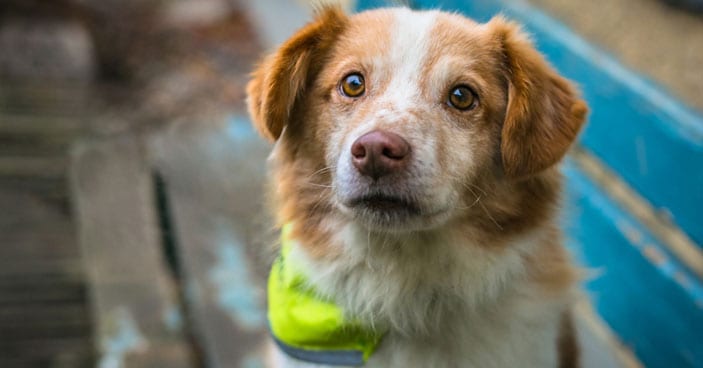
Become a Jedi master of chill…
Try your best to not hype up your pooch with promises of ‘walkies, walkies’ (yes I know it’s the highlight of your day!).
Starting the walk with a calm attitude will again lead to a far more enjoyable experience in the long run.
Many of us have our dogs running the show from the word go, dragging us out the door, and charging down the driveway. By this point your friend at the other end of the leash has made all the decisions, all the while taking no notice of you.
Dogs are so logical and very clever at understanding who is deciding what happens and when. So, if they are bringing you their leash and pushing you out the door, then they are in charge.
But, if you choose when it’s time to go out, and only put their leash on when they are relaxed and chilled, they soon figure out that that’s how walks will actually begin. Check out these other naughty behavior solutions if you have a younger puppy.
Good dog!
Make sure it ends well…
Finishing the walk is also an important part of the process. It should always end calmly and positively. The walk isn’t always an instant fix – with some dogs it’s something that you have to chip away at but with time.
But, if you walk the dog calmly from the start they will simply understand that this is how it has to be and they will stop pulling you around the block.
Keeping these tips in mind when you prepare for a walk is a good place to start. To read get a few more tips, I encourage you to read the blog I originally wrote on this topic.
Read the entire How to Walk a Dog blog post HERE.
Once you’ve got the basics covered, it’s important to think about the things that you might encounter while on a walk, such as another dog.
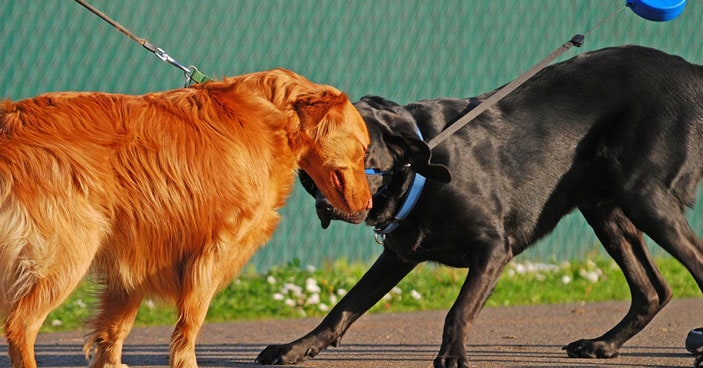
If your dog is friendly, there’s no harm in allowing him to meet a new friend while you’re out walking. After all, dogs are a very social creatures and most enjoy interacting with other canines.
You do, however, have to be careful about how you introduce your pup to a strange dog. If rushed, a friendly introduction can quickly turn into a nightmare .
Here’s what I recommend…
How to Introduce Dogs on a Walk Correctly
So often, greeting another dog on a leash becomes a total disaster, with both owners apologising for their dog’s behaviour and neither dog enjoying the experience.
Neither owner is sure what the correct meet and greet procedure is, or the what the right thing to say is, and we become too involved in what should be a purely dog affair.
So I have put this video together so that you have a few key pointers up your sleeve for next time you.
I’ve also got 5 important tips that I’ve written out for you. Check them out on my How to introduce dogs on a walk correctly blog.
Now this brings us to the million dollar question… “What if my dog becomes too excited or aggressive during a greeting?
Great question!
Here’s my answer…
Excited And Aggressive Dog Greetings
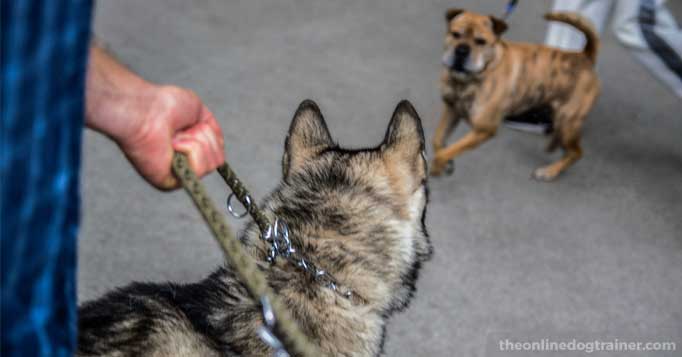
There are 3 main solutions to manage an aggressive or excited dog greeting…
- Walk away – if your dog is way too excited
- Let them meet – if your dog is calmer than usual and not being aggressive
- Calm your dog down, then make a decision – this is where the training comes in!
It may sound a bit obvious but having those three options clear in your mind will give you some immediate direction as you approach a dog. Knowing what your options are helps you to select the right one which in turn will help you to achieve your goal. I've also dedicated a recent post to How to approach an aggressive dog HERE.
The real key to success is knowing how to calm your dog down. To help give you a better understanding of how to do that, I’ve put together a podcast for you where I talk about….
- Practical tools and techniques – some of the methods that I use everyday for calming your dog down that are especially useful on the walk and at the park
- How being the pack leader at home will result in a completely different dog at the park (calmer!)
- The trick of calming an over excited dog and what you are trying to achieve when you are training them to be calm. (this is a very subtle point but is crucial for success and often overlooked.)
Take a listen!
If you’ve tried everything I’ve recommend so far without any success, don’t worry. The first thing I want you to know is that leash training takes time. It’s not a skill that every dog picks up with one day of practice.
Second, I have a few more suggestions I want to offer to you to help make your dog walking experience less dangerous that I truly believe will help.
Here we go…
When the walk becomes dangerous…
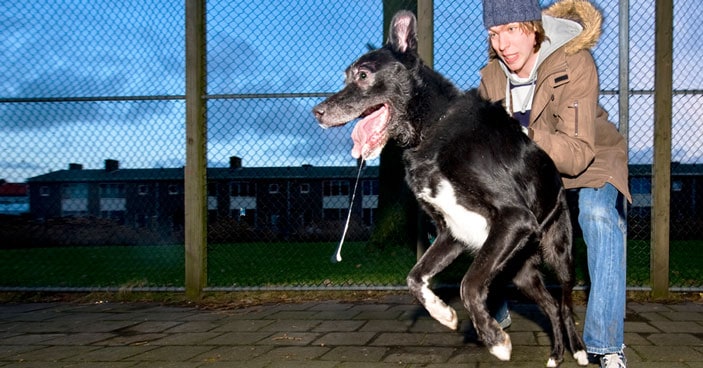
Taking your dog for a walk is supposed to be one of those pleasant experiences; relaxing, enjoyable and
memorable. However for many people it’s memorable for all the wrong reasons!
There’s nothing worse than being dragged down the street, pulled off your feet, arm yanked out of its socket, damaged wrists and a lot of stress.
It can actually be quite frustrating to see other dog owners with their dogs walking nicely beside them off leash!
One lady I worked with told me about her how she had just bought a coffee to enjoy whilst walking her two black Labradors, when they spotted another dog and charged towards it.
She ended up clinging to a lamppost, arms and legs wrapped around it, coffee in one hand and two dogs in the other!
That was the final straw… She called me for help as soon as she made it home.
So, how do you go from this crazy situation where your dog is out of control from the very start to having a nice calm walk?
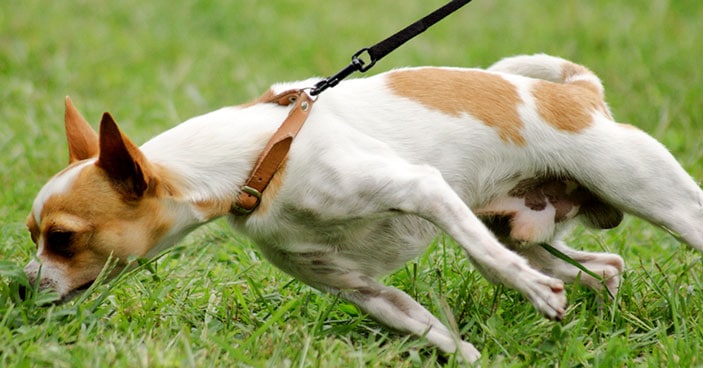
You have to start right at the beginning.
Before you continue reading, I encourage you to take a listen to the following podcast. Then, continue on to check out a few of the process’s that I recommend…
Taking the top off the dog’s energy first
In maybe 1-in-20 difficult dogs who pull on the leash, I will apply this method of draining some of the dog’s energy before attempting to get them under control. Many of these dogs have not been for a walk for a long time as it’s become too stressful and dangerous for the owners, the dog and the public.
The approach I explain in the podcast is simple but it needs to be done correctly or you’ll get nowhere fast because it’s very subtle, and it’s easy to miss the whole point. Here’s the general idea of what we’re doing.
The Standard Approach
Let me first summarize the standard approach to calming your dog down before the walk.
Usually when we’re training our dogs to stay calm and walk nicely on the leash, we only continue with the walk if your dog is calm. So, we would only progress through the door if your dog has calmed down to a reasonable level.
Then we would only progress down the garden path if your dog is still calm. Simple enough?
To see exactly how to do this and get your walk off to a good start watch this video…
However, with a very small number of dogs, this is never going to happen!
Some dogs are just so super-charged up, due to their age, character, lack of exercise, breed, situation and many other factors, that it’s almost impossible for them to calm down before we take the top off their energy.
Breaking Old Habits and Creating New Ones
This approach looks at taking them for a good run at the park. The clever and very subtle part is how we take advantage of our tired out dog when we return home and immediately put in place some brand new habits!
Breaking old habits and forming new ones, new associations and new ways of behaving is half the battle. Once you get started it’s so much easier to keep improving.
I encourage you to keep my blog post, Leash training – When Your Dog is Too Excited to Walk somewhere where you can easy come back and access it. When you are consistent with the methods I explained from that post, you will find success.
To wrap up my thoughts on leash training, I wanted to talk about a bizarre but common problem I’ve noticed in several dogs I’ve worked with…leash biting/chewing.
How to Stop Your Dog From Chewing the Leash
Before we being, take a quick look at this video of a dog named Ruby.
The Issue
As you can see, as soon as the leash came out, even in the back garden, little Ruby would go pretty crazy. Pulling and yanking and mouthing and chewing the leash.
She is a small dog but she could still pull pretty strong and was very tenacious. She didn’t give up, even on long walk, she’d keep pulling all the way down the road and across the street. She’d be dragging you here, dragging you there.
And she just wouldn’t stop. Pull, pull, pull. Chew, chew, chew. It was a nightmare.
The Solution
Let me show you a simple way of correcting this behavior. As always, the key to everything was gaining Ruby’s trust and respect. And, I did that through implementing and putting in place The Dog Calming Code.
Now here’s the little trick that helped me establish more respect on the walk.
One very simple way of getting her to change her behavior was to put a little chain through her collar, so that the first part of her leash is now a chain. But, she still had a soft little fabric collar on.
Now, Ruby was still free to jump up and chew the chain if she wanted to. It was totally her choice. There was no shouting or pulling on the leash from me. We just let her change her behavior of her own free will.
At the start she had a look, thinking “I’ll try and jump up and get the leash.” She had one good jump but couldn’t reach it and then said, “Fine.” It’ was as quick as that. Now, she’s a changed dog. She’s doesn’t bother chewing the chain anymore. She just walks nice and sensibly.
End Result
As you can see, very soon she was walking perfectly by my side. Happy to walk behind me, very loose leash and she wasn’t chewing it. And,even on the way back home, still a very loose leash — and remember this is outside — we’re not in the garden anymore.
There are far more distractions, but she was perfect.
I Wish You a Lifetime of Enjoyable Walks
There you have it…a complete guide to help you successfully leash train your dog so you can enjoy calm and relaxing walks with your dog.
I really hope you’ll give my methods a try. As I said before, any type of training—including leash training—takes time. But when you’re persistent, I promise that the hard work will pay off.
For additional tools, tips, and resources on everything from potty training to dog aggression, I invite you to check out a blog post where I share my secret to training over 88,000 dogs successfully!
Cheers!

~Doggy Dan







22 Responses
Hi Doggy Dan, I appreciate your videos and articles very much, they really helped me with training my pup. My small poodle is very picky with her food, so my dog trainer recommended “hand feeding” her. It’s basically that you take some freeze dried raw food, you divide the food into two meals, and when you’re outside and let her off leash, you call her once in while and feed her a small portion of the food. (It can also be used inside for tricks, but the food shouldn’t be offered “for free”). Hand feeding helped me a lot with her feeding and training. But I don’t know how to combine it with your training program( Dog calming code). Do you think it is a good idea to use it in my training? And how should I combine it with your program?
Thank you for your advice.
Lily
Hi Lily,
One of the 5 components of my Dog Calming Code deals directly with feeding our dogs, and how to overcome fussy eating dogs. The format we advise when feeding your dog is designed to mimic how they instinctively feed, so my advice would be to follow those guidelines consistently and exactly as advised. The issue with handfeeding a dog is that is can send them some really confusing signals when it comes to their role in their family/pack….and it can therefore result in other issues. When you do follow my feeding guidelines you may be surprised just how quickly your dog becomes less fussy! Hope that helps! Doggy Dan
I have an 80 lb. Staffordshire Terrier.
I have used your methods and he walks beside me down the road very well but if he wants to walk further in that same direction and I want to turn and walk back in the direction we came from, back towards the house, he will lay down and I can’t budge him to get him up. If he doesn’t get up I have to eventually grab his collar and pull him up to get him moving again and he is very heavy. How do I stop his stubborn laying down during our walk.
Hi Lia…If your dog tends to resist at a certain location on your walk then this will allow you to plan ahead! Have some high value treats ready and introduce those BEFORE he starts to resist, to try and keep him engaged and moving forward. It’s really important that you don’t use treats when he has already stopped walking….if you do you will be rewarding the wrong behaviour and he may learn to resist just to try and get a treat….dogs are smart! If you are familiar with Stop, Start & Change direction then you can also use this at the point where you can see him starting to lose focus on the walk….again we use this before he resists and it’s a nice reminder for him that you make the decisions and you would like him to follow your lead. All the Best, Doggy Dan!
My dog runs under the bed when I get the leash out. How do I get her to want to have the leash on for walks?
Hi Edie, the outside world can be a really scary place for some dogs and it can be common for them to be reluctant to go out for a walk. You can certainly help improve your dog’s confidence with a little practice and the right information. My website TheOnlineDogTrainer.com shows you very clearly how to achieve this…maybe take a quick look…its a $1USD trial for 3 days…All the Best, Doggy Dan
I would like your advise on how to do to introduce my daughter’s cat to my dog as they will share the same house during next summer.
Hi Monique, the best way to go about this is to initially put controls in place that will avoid a potentially negative relationship while they are settling in together. Having your dog on-leash is a great way to do this as you can avoid being in a situation where you are not in control of the introduction. Also make sure both animals are calm and relaxed and start off by just aiming to have them calmly in the same room together without rushing a close encounter. If your dog starts to react negatively then calmly place the dog out of the room until they are calm, and then try again. It’s important for you to also remain calm and be really consistent and clear with the behaviour you expect from your dog. My website TheOnlineDogTrainer.com shows you very clearly how to handle this introduction as well…maybe take a quick look…all the best Doggy Dan
Hello Dan !!!
I’m So impressed with what I’ve read and watched today ❣️
My dog has just had an operation so I’m hoping when he’s recovered I will “Try” all the Wonderful Advice !!!
Can u ask if you Do Home Visits ?
Thank you again
Sincerely Caroline
Hi Caroline, I wish your dog a speedy recovery! I do home visits, depending on where you live, and I also have my Dog Trainer Academy graduates dotted all over the world. Get in touch with our head office and they will be able to steer you in the right direction. Best, Doggy Dan
Hi. I have rescued a 4yo retired show dog. Whenever l put a leash on her she becomes a statue and does not budge. She will drag leash to a treat but as soon as l pick up leash she freezes. Can you help us?
Hi Deb! A little practice can go a long way with this type of behaviour. Use some high value treats to help encourage your dog to work with you and start by doing lots of really short, frequent training sessions around your home. Use the treats to keep her moving and be sure to praise her when she gets it right. Aim just to get her to move one or two steps forward with you holding her leash and gradually extend this with each practice session. You can phase the treats out when she is moving for voluntarily. My website TheOnlineDogTrainer.com will also be able to help you address this behaviour…maybe take a quick look…its a $1USD trial for 3 days…all the best Doggy Dan
WE have an Irish Setter that pulls. Will try the methods you describe. But along the walk if he is along side, and then want to go to the bathroom or sniff the trees, how does one let him do that, which means him typically going sideways to the tree bush, etc, necessary at some point on walk, while still working on not pulling fwd or sideways for that matter. Then if the leash is slack and he sees a bird, there is the lunge???
Hi Jack,
Generally I allow a dog to toilet at the start of the walk and then after that I like to keep them dog moving rather than stopping regularly to allow them to stop and sniff things. Of course some dogs do take a little time to work up to going to the toilet so you do need to also make allowances for this. On a structured walk I do prefer to keep a dog moving but I do allow them to have some free time at some point on the walk to sniff and explore a little. You will know your dog’s signals and will therefore be able to identify if he just wants to stop and sniff or if he does needs to go to then toilet. All the best….Doggy Dan
Hello Doggy Dan!
Thank you for another great post. My 6 m.o. beagle mix puppy is one of those super-charged dogs. Walking her is impossible, it’s as if she doesn’t think I really need one of my arms :), that’s how hard she’s pulling with all of her 15 pounds of weight. I’ve been trying to keep her behind me, then she learned to walk between my feet (the only way when she isn’t pulling), this is also very exhausting. I did SSCD, calm freeze, etc., All that only calms her down for a few seconds. She reacts to sounds (like someone’s steps a few feet away, or a neighbor opened a window, etc..), it’s really hard to keep her calm. I’m going to take her to a dog park today after work, I’m thinking maybe I need to carry her all the way there? Otherwise she’ll just be pulling for 15 minutes with a 10 points energy level, and also barking and growling at every dog we meet on our way. Do you think carrying her is a good idea? Or should I just walk her to the park? Even after 30 minutes of running in the park she keeps on pulling while we walk back home. While in the park, she is restlessly chasing other dogs, she runs non-stop like a mini greyhound! I wish there were Olympic games for puppies, she’d win all the marathons and srpints! haha)
Thank you!
Laura
Hi Laura,
When we have owners who are having issues when walking their dogs, we always advise them to review the beginning of the walk before you have even left the house. Ensuring that your dog is calm and relaxed before you leave your property is a key component in how they will then behave when on the walk. If they are highly excited before you even leave the house then you have already lost control of the walk. Practice is key but make sure you throw in lots of extra practice at times when you have no intention of going anywhere. This will allow you to teach your dog how you expect her to behave when she is on the leash, and the great thing is you will have fewer distractions to master the rules initially. You don;t have to spend hours at a time practicing, just break it up into little practice sessions throughout the day. Remember to keep excitement levels low and to correct any pulling as advised. If things get too excited then end the lesson and try again later. When you feel ready you can then head out into the Street and extend on the lesson by showing your dog that the rules are the same here as well. You may not get very far initially which is fine because distance is not the aim at this point. It is far more important that you are consistent in correcting any pulling on the leash. If you do want to practice at the park then it is better to carry your dog there than it is to allow her to drag you the entire way, but either way practicing at home will be key! My website TheOnlineDogTrainer.com shows you very clearly how to achieve this…maybe take a quick look…its a $1 trial for 3 days…all the best Doggy Dan
Hi there, what type of harness is in the video. There’s so many out there, its hard to choose. Plus my puppy is getting bigger and stronger everyday and wrist and shoulder keeps getting yanked from his pulling.
Hi Dianne,
The harness in the video is called an Easy Walk/Gentle Lead harness. The leash clips onto the chest area of the harness so when the dog pulls or lunges it turns the dog back towards the owner and takes some of the force out of their pulling. It is particularly helpful for larger breeds or dogs who are particularly strong. No device will replace giving your dog good information though so practice the techniques and advise in my Blog and you should see some improvements in your dog’s behaviour on the walk. Best…Doggy Dan
What do you do for a dog age 1 1/2 that is so shy that the sight of the leash sends him under the bed. I have had him since he was 9 1/2 weeks and there seems to be no hope. He has never been traumatized on a leash. I have let him wear the leash around the house but the big world frightens him
Hi Carol,
The prospect of going for a walk can cause many dogs to become fearful and reluctant to go out. If you think about the reality for them, leaving the safety and security of their home and entering into a world of dangers and unknowns then the fear is understandable. A key part of helping a dog overcome any fear is to show them that they can trust you to keep them safe and that’s what my membership website is all about. On a more practical side, practice desensitising your dog to the leash by carrying it around the house with you at regular intervals and if he becomes agitated then simply put it down and do something else. It’s best not to try and call him over until he is relaxed when he sees the leash and you may need to use high value treats and also not have the lead in your hand (place it on the floor) when you do so. It’s then a process of building on this routine, making it a positive association rather than a negative one. Hope that helps…Doggy Dan
Thank you! I have not seen one trainer, start in the house with leash manners. I train my clients, as you stated above. Place the leash on a calm dog. I go further, pick up the leash collar like you are picking up your car keys to go get gas. Stop “Hey Fido want to go for a walk”? So now you have a dog at a level 5 or above, now take him out with all those scents, distractions. Now he’s at a level 10! Let them be a dog, bathroom, sniffing etc. for the first 5-10 minutes of walk, release some of the energy. Then the walk is a training/bonding session. YOU ARE ON YOUR FIRST DATE WITH YOUR FUTURE MATE! Train, play, praise. Nothing else matters. Cell phones are for emergencies. One other thing I add is tether the dog to you in the house for a few days. This helps with the dog learning he needs to be by my side (among other things). Great article.
Hi Jerry. Yes the stat of the walk, from the moment an owner even thinks about going out, has a significant effect on how a dog behaves when on the walk and it’s always the first thing I review when owners tell me they are having issues. It’s pretty obvious when you think about it but often owners just aren’t aware of the scenario from their dog’s perspective and what they need to feel confident in their owner’s ability to lead. Keep up the great work! Dan